
Goodison Park is a football stadium in the Walton area of Liverpool, England, 2 miles (3 km) north of the city centre. It has been the home of Premier League club Everton since 1892 and has an all-seated capacity of 39,414.
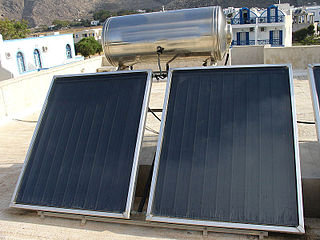
A solar thermal collector collects heat by absorbing sunlight. The term "solar collector" commonly refers to a device for solar hot water heating, but may refer to large power generating installations such as solar parabolic troughs and solar towers or non water heating devices such as solar cooker, solar air heaters.

A central heating system provides warmth to a number of spaces within a building from one main source of heat. It is a component of heating, ventilation, and air conditioning systems, which can both cool and warm interior spaces.

Dens Park, officially known as Scot Foam Stadium for sponsorship reasons, is a football stadium in Dundee, Scotland, which is the home of Scottish Premiership club Dundee F.C. and has a capacity of 11,775. Tannadice Park, the home of rivals Dundee United, is just 200 yards away.

Rugby Park, also known as The BBSP Stadium Rugby Park for sponsorship reasons, is a football stadium which is the home of Scottish Premiership club Kilmarnock F.C. and is situated in the Scottish town of Kilmarnock. With a capacity of 15,003, it is the 7th–largest football stadium in Scotland, and was first used in 1899, also having been used for concerts, rugby union and international football fixtures. The stadium underwent a major redevelopment in 1994–1995, becoming an all-seater stadium with a capacity of 18,128. In 2002, the club constructed the Park Hotel, a 4-star hotel complex next to the ground.
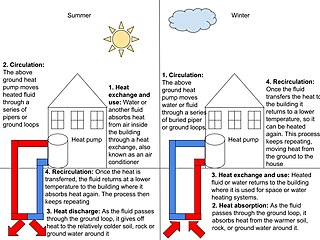
Geothermal heating is the direct use of geothermal energy for some heating applications. Humans have taken advantage of geothermal heat this way since the Paleolithic era. Approximately seventy countries made direct use of a total of 270 PJ of geothermal heating in 2004. As of 2007, 28 GW of geothermal heating capacity is installed around the world, satisfying 0.07% of global primary energy consumption. Thermal efficiency is high since no energy conversion is needed, but capacity factors tend to be low since the heat is mostly needed in the winter.

Deicing is the process of removing snow, ice or frost from a surface. Anti-icing is the application of chemicals that not only deice but also remain on a surface and continue to delay the reformation of ice for a certain period of time, or prevent adhesion of ice to make mechanical removal easier.
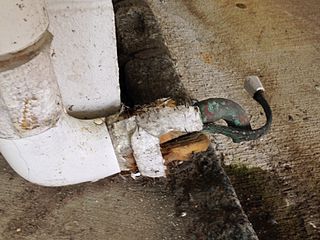
Electric heat tracing, heat tape or surface heating, is a system used to maintain or raise the temperature of pipes and vessels using heat tracing cables. Trace heating takes the form of an electrical heating element run in physical contact along the length of a pipe. The pipe is usually covered with thermal insulation to retain heat losses from the pipe. Heat generated by the element then maintains the temperature of the pipe. Trace heating may be used to protect pipes from freezing, to maintain a constant flow temperature in hot water systems, or to maintain process temperatures for piping that must transport substances that solidify at ambient temperatures. Electric trace heating cables are an alternative to steam trace heating where steam is unavailable or unwanted.

Victoria Park, also known as the Global Energy Stadium for sponsorship reasons, is an all-seater football stadium in the town of Dingwall, Highland, Scotland. It is the home ground of Ross County, who currently play in the Scottish Premiership.

New Douglas Park is a football stadium in Hamilton, South Lanarkshire, Scotland, which serves as the home of Scottish League One side Hamilton Academical and Scottish League Two side Clyde. It takes its name from Douglas Park, the club's former stadium which was located immediately to the south of the current site.

Stadion Evžena Rošického, also known simply as Strahov, is a multi-purpose stadium in Strahov, Prague in the Czech Republic. It hosted the 1978 European Athletics Championships and for many years this was the venue for main annual international track and field meet of Prague until Stadion Juliska took the role in 2002. Since then the stadium has used only for minor domestic athletic competitions and mostly for football matches. It served as the home ground for SK Slavia Prague from August 2000 until May 2008 when their new stadium, the Synot Tip Arena, was opened. It is also occasionally used by other Czech teams, and is the usual venue for the Czech Cup final.

Lillestrøm idrettspark, colloquially known as Lillestrøm stadion, is a sports facility located at Lillestrøm in Skedsmo, Norway. The main venue is Romerike friidrettsstadion, an athletics stadium with eight all-weather running tracks. It has multiple football pitches, including one with artificial turf and one with gravel. The park features of two arenas, LSK-Hallen with a full-size artificial football pitch and Skedsmohallen for indoor sports. The venue is located adjacent to Åråsen Stadion, the home ground of Lillestrøm SK. The main tenants for Lillestrøm idrettspark are Flisbyen BK and Focus FK in football, and Strømmen IF, Lørenskog FIL and Minerva IS in athletics. The stadium opened on 6 June 1920 and was the main venue for Lillestrøm SK until 1951. The athletics stadium opened two years later. In 2004, the artificial turf pitch was laid and in 2007 a new athletics venue and LSK-Hallen opened.
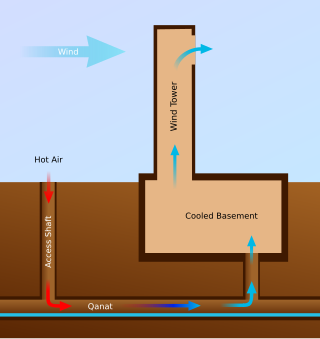
A ground-coupled heat exchanger is an underground heat exchanger that can capture heat from and/or dissipate heat to the ground. They use the Earth's near constant subterranean temperature to warm or cool air or other fluids for residential, agricultural or industrial uses. If building air is blown through the heat exchanger for heat recovery ventilation, they are called earth tubes.

Underfloor heating and cooling is a form of central heating and cooling that achieves indoor climate control for thermal comfort using hydronic or electrical heating elements embedded in a floor. Heating is achieved by conduction, radiation and convection. Use of underfloor heating dates back to the Neoglacial and Neolithic periods.
Turf management or pitchcare describes the work needed to keep a sporting pitch ready for use. This article looks at the various types of sporting pitches and the type of challenges which they present.
Seasonal thermal energy storage (STES), also known as inter-seasonal thermal energy storage, is the storage of heat or cold for periods of up to several months. The thermal energy can be collected whenever it is available and be used whenever needed, such as in the opposing season. For example, heat from solar collectors or waste heat from air conditioning equipment can be gathered in hot months for space heating use when needed, including during winter months. Waste heat from industrial process can similarly be stored and be used much later or the natural cold of winter air can be stored for summertime air conditioning.

A ground source heat pump is a heating/cooling system for buildings that use a type of heat pump to transfer heat to or from the ground, taking advantage of the relative constancy of temperatures of the earth through the seasons. Ground-source heat pumps (GSHPs) – or geothermal heat pumps (GHP), as they are commonly termed in North America – are among the most energy-efficient technologies for providing HVAC and water heating, using far less energy than can be achieved by burning a fuel in a boiler/furnace or by use of resistive electric heaters.

A snowmelt system prevents the build-up of snow and ice on cycleways, walkways, patios and roadways, or more economically, only a portion of the area such as a pair of 2-foot (0.61 m)-wide tire tracks on a driveway or a 3-foot (0.91 m) center portion of a sidewalk, etc. It is also used to keep entire driveways and patios snow free in snow prone climates. The "snow melt" system is designed to function during a storm to improve safety and eliminate winter maintenance labor including shoveling, plowing snow and spreading de-icing salt or traction grit (sand). A snowmelt system may extend the life of the concrete, asphalt or under pavers by eliminating the use of salts or other de-icing chemicals, and physical damage from winter service vehicles. Many systems are fully automatic and require no human input to maintain a snow/ice-free horizontal surface.
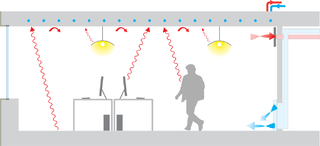
Radiant heating and cooling is a category of HVAC technologies that exchange heat by both convection and radiation with the environments they are designed to heat or cool. There are many subcategories of radiant heating and cooling, including: "radiant ceiling panels", "embedded surface systems", "thermally active building systems", and infrared heaters. According to some definitions, a technology is only included in this category if radiation comprises more than 50% of its heat exchange with the environment; therefore technologies such as radiators and chilled beams are usually not considered radiant heating or cooling. Within this category, it is practical to distinguish between high temperature radiant heating, and radiant heating or cooling with more moderate source temperatures. This article mainly addresses radiant heating and cooling with moderate source temperatures, used to heat or cool indoor environments. Moderate temperature radiant heating and cooling is usually composed of relatively large surfaces that are internally heated or cooled using hydronic or electrical sources. For high temperature indoor or outdoor radiant heating, see: Infrared heater. For snow melt applications see: Snowmelt system.

Cold district heating is a technical variant of a district heating network that operates at low transmission temperatures well below those of conventional district heating systems and can provide both space heating and cooling. Transmission temperatures in the range of approx. 10 to 25 °C are common, allowing different consumers to heat and cool simultaneously and independently of each other. Hot water is produced and the building heated by water heat pumps, which obtain their thermal energy from the heating network, while cooling can be provided either directly via the cold heat network or, if necessary, indirectly via chillers. Cold local heating is sometimes also referred to as an anergy network. The collective term for such systems in scientific terminology is 5th generation district heating and cooling. Due to the possibility of being operated entirely by renewable energies and at the same time contributing to balancing the fluctuating production of wind turbines and photovoltaic systems, cold local heating networks are considered a promising option for a sustainable, potentially greenhouse gas and emission-free heat supply.

















